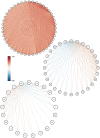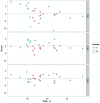Principal networks
- PMID: 23630578
- PMCID: PMC3632613
- DOI: 10.1371/journal.pone.0060997
Principal networks
Abstract
Graph representations of brain connectivity have attracted a lot of recent interest, but existing methods for dividing such graphs into connected subnetworks have a number of limitations in the context of neuroimaging. This is an important problem because most cognitive functions would be expected to involve some but not all brain regions. In this paper we outline a simple approach for decomposing graphs, which may be based on any measure of interregional association, into coherent "principal networks". The technique is based on an eigendecomposition of the association matrix, and is closely related to principal components analysis. We demonstrate the technique using cortical thickness and diffusion tractography data, showing that the subnetworks which emerge are stable, meaningful and reproducible. Graph-theoretic measures of network cost and efficiency may be calculated separately for each principal network. Unlike some other approaches, all available connectivity information is taken into account, and vertices may appear in none or several of the subnetworks. Subject-by-subject "scores" for each principal network may also be obtained, under certain circumstances, and related to demographic or cognitive variables of interest.
Conflict of interest statement
Figures








References
-
- Bullmore E, Sporns O (2009) Complex brain networks: graph theoretical analysis of structural and functional systems. Nature Reviews Neuroscience 10: 186–198. - PubMed
-
- Euler L (1741) Solutio problematis ad geometriam situs pertinentis. Commentarii academiae scientiarum imperialis Petropolitanae 8: 128–140.
-
- Bernhardt BC, Chen Z, He Y, Evans AC, Bernasconi N (2011) Graph-theoretical analysis reveals disrupted small-world organization of cortical thickness correlation networks in temporal lobe epilepsy. Cerebral Cortex 21: 2147–2157. - PubMed
-
- Kaiser M, Varier S (2011) Evolution and development of brain networks: From Caenorhabditis elegans to Homo sapiens. Network: Computation in Neural Systems 22: 143–147. - PubMed
Publication types
MeSH terms
Grants and funding
LinkOut - more resources
Full Text Sources
Other Literature Sources

